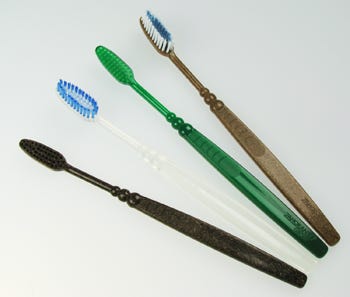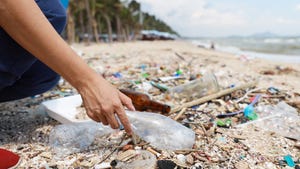Worldwide, every other toothbrush is produced on a Zahoransky machine. In 1988, the toothbrush market was revolutionized with the emergence of the first two-component injection mold for toothbrushes. And while today moldmaking, packaging machines and systems technology are all core competencies of the Black Forest-based Zahoransky Group, the simple toothbrush continues to form a source of inspiration for innovation.
January 11, 2012
Worldwide, every other toothbrush is produced on a Zahoransky machine. In 1988, the toothbrush market was revolutionized with the emergence of the first two-component injection mold for toothbrushes. And while today moldmaking, packaging machines and systems technology are all core competencies of the Black Forest-based Zahoransky Group, the simple toothbrush continues to form a source of inspiration for innovation.

Zahoransky bioplastic toothbrush
The company has now developed a new disposable toothbrush made of biopolymer composite material, for distribution in hotels and airplanes. The biologically degradable fiber-filled compound is composed of waste paper fibers that have been pressed to free-flowing bulk solids and a biobased matrix of PHB, PLA or similar biomaterial.The tooling and injection molding technology were successfully implemented in collaboration with the West Saxony University of Applied Sciences Zwickau. The toothbrush, according to Zahoransky, is now ready for series production and offers "a resource-saving alternative for disposable solutions in the hotel and air travel areas."
The company has also developed a new lead and colored pencil manufacturing process, in which the sheaths are made completely of natural fiber-reinforced bioplastic. Both sheath and lead are produced in a single operation during the injection molding process.
The traditional production of lead and colored pencils was both cost and energy intensive, as this required 13 work cycles. In a project that involved Zahoransky, Chemnitz Technical University and a leading stationery manufacturer, an innovative, sustainable and cost-cutting production process that involves the two-component injection molding of the complete, ergonomically designed pencil was developed and is also ready for series production.
The new products illustrate Zahoransky's commitment to sustainability, which lies at the very heart of its group research program. As the company itself says: "From energy saving measures, the use of biobased raw materials through to increases in productivity, the issues of the future are already being innovatively addressed."
About the Author(s)
You May Also Like


